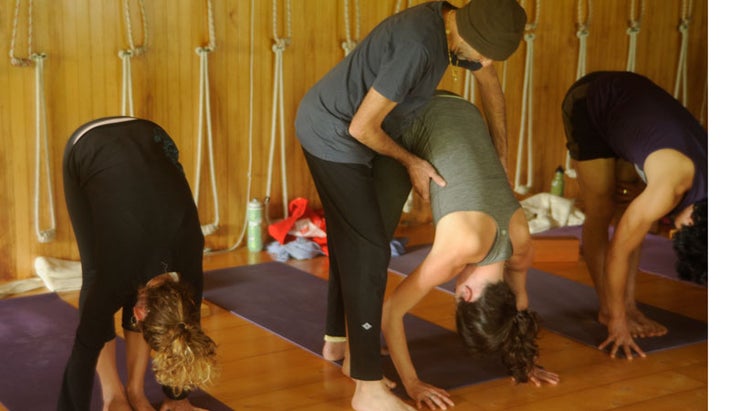Heading out the door? Read this article on the new Outside+ app available now on iOS devices for members! Download the app.

Understanding the anatomy of the spine and the limits of the joints is very important for both yoga teachers and practitioners, says Eddie Modestini, a longtime student of K. Pattabhi Jois and B.K.S. Iyengar, who will lead Yoga Journal’s upcoming online course, Vinyasa 101: The Fundamentals of Flow. Sign up now to be the first to know when this essential guide to vinyasa yoga launches.
Asking the spine to move in a way it’s not supposed to or going beyond a joint’s range of motion can lead to injury. Here are 3 ways that understanding the anatomy of the spine can help you practice yoga safely, improve your forward bends and twists, and avoid back pain and arthritis.
READ MORE Vinyasa 101: 4 Ways to Avoid Yoga Injuries
3 Things Every Yogi Must Know About the Anatomy of the Spine
1. The sacrum is not supposed to move.
The sacrum, or sacred bone (triangular bone in the pelvis), is meant to stabilize. It is the most important stabilizing factor in the bridge between the upper body and the lower body. There’s very little movement there; it only correctly moves during childbirth. Some yoga teachers are inviting students to lift their tailbone, spread their sitting bones, and open their chest or extend their spine in forward bends. This is causing instability in the sacroiliac joint (the joint between the sacrum and the ilium bone in the pelvis), which can cause chronic back pain.
2. Avoid pushing bone into bone.
If you don’t understand the limiting factors of the spine, you could be pushing bone into bone, which is almost always contraindicated in yoga. All joints have a limit in their range of motion. When you exceed that limit, then bone hits bone (hot, sharp pain could be a warning sign). When bone hits bone, it starts to break down, which could lead to a breaking down of the joint, because a joint is surrounded by cartilage. Cartilage has the ability to lubricate—when you start grinding bone into bone, it breaks down the cartilage and can’t retain synovial fluid, which means it can’t lubricate anymore, and you can develop arthritis. Avoid pushing bone into bone by moving slowly with the breath, and finding an experienced teacher that knows how to look at the body.
3. Extend the spine during twists.
Students are often taught to twist around the navel or the lower back, but the facet joints between the lumbar vertebrae are designed to flex and extend, not to twist. If you overemphasize the twist in the lower back, it puts pressure on the sacroiliac joint, causing sacroiliac joint instability. Another side effect of overemphasizing the twist in the lower back is facet joint syndrome, where the cartilage is worn down on the facet joints. Facet joint syndrome can lead to back pain and arthritis. There should be more emphasis on extending the spine than on twisting the spine, even though the poses are called twists. When you understand the anatomy of the spine and the joints therein, you can move deeply into your practice in a safe, compassionate, and loving way.
READ MORE Vinyasa 101: Is Your Yoga Class Too Fast?
Eddie Modestini is the co-director and co-owner of Maya Yoga Studio in Maui. Want to learn more ways to injury-proof your practice, whether you’re a teacher or a student? Sign up for Modestini’s upcoming Vinyasa 101 course, which will cover the anatomy of the spine, how to adapt asana for various body types, and much more.